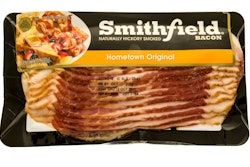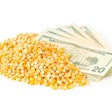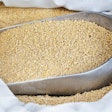
As global commodity supplies shrink, concern about US weather drives price volatility
The U.S. Department of Agriculture (USDA) may have notched projected 2021 corn and soybean crop prices downward, but experts say whether commodity prices stay that way depends on how this summer’s weather unfolds.
The USDA’s July World Markets and Trade reports dropped the estimated on-farm value of the 2021 corn crop by 10 cents to US$5.60 per bushel, and cut soybeans 15 cents to US$13.70 after increasing projected production for both commodities. Nagaraj Meda, managing director of risk management firm TransGraph Consulting, told the U.S. Soybean Export Council on July 12 that he believed reduced imports into China accounted for the majority of these cuts. Sustained high prices, he said, seemed to be curbing China’s enthusiasm for U.S. soybeans.
But even with additional production and a slowdown in purchases by China, economists say global supplies of corn and soybeans remain low.
James Mintert, director of the Center for Commercial Agriculture at Purdue University, said he had thought estimates released in March represented the final tally for the amount of corn the U.S. would have leftover from 2020 as the next marketing year began. But projected carryover has continued to fall, Mintert said, driving continued high prices.
With U.S. corn and soybean acreages essentially maxed out, two remaining wild cards will determine where prices for upcoming crops will land, Mintert said during a July 14 webinar. Ethanol production has finally exceeded pre-pandemic levels, but continued production remains a question, with prices for ethanol, usually used to decrease the cost of gasoline, now exceeding the cost of unleaded gas itself, he said.
The other remaining question, Mintert said, is crop yields, which look increasingly uncertain as severe drought in the Western U.S. spills over into corn- and soybean-producing states in the Midwest.
The worst drought is concentrated North Dakota and Minnesota, according to Michael Langemeier, associated director of the Center for Commercial Agriculture, with both states reporting a very low percentage of crops rated in good condition. He estimated those states accounted for roughly 19% of the corn acreage planted this year.
“You’re going to see some lower yields in those regions, pretty likely, Langemeier said.
Uncertainty about crop yields has triggered “phenomenal swings” of a dollar or more in futures markets, according to Nathan Thompson, an assistant professor in Purdue’s Department of Agricultural Economics. While corn was selling for US$5.43 per bushel and soybeans for US$13.61 per bushel as of the morning of July 14, Thompson said there was a good chance prices won’t stay that high. He gave soybean prices a 33% chance of falling by US$1 or more before the end of the year. Corn, he said, had a 20% chance of dropping by more than US$1.
“The market could move strongly in that direction,” he said. “There’s a good chance of that happening between now and fall.”











